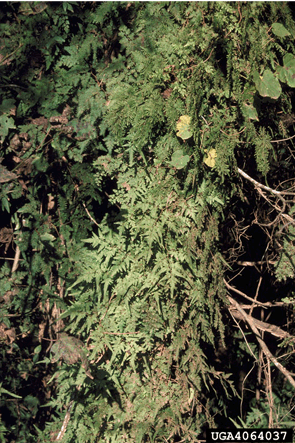
Plant: Japanese climbing fern (Lygodium japonicum) is a climbing and twining perennial vine-like fern native to Asia and tropical Australia.
Identification: This fern has lacy finely-divided leaves along green to orange to black wiry vines that can grow up to 90 ft long. Stems are slender but difficult to break; they are twining and climbing, wiry, green to straw-colored or reddish. Fertile fronds have smaller segments with fingerlike projections around the margins that bear spore producing dots in double rows under margins. Seeds are tiny spores mainly dispersed by wind.
Ecology: Japanese climbing fern spreads along highway rights-of-way (preferring under and around bridges) and invades into open forests, forest road edges, and stream and swamp margins. Scattered in open timber stands and plantations, it can quickly increase in cover to form mats, covering shrubs and trees. This fern is deciduous in late winter, while dead vines provide lattice for new growth.
The Japanese climbing fern resembles the American climbing fern (native) and Old World climbing fern (non-native and only in Florida) with both having palmately lobed 5 to 7 finger-like fronds. American climbing fern occurs in swamps, streambeds, and ravines, and confines its spread to small areas limiting extensive infestations.
Herbicide Control: Apply a 41% active ingredient of glyphosate herbicide (Accord, Razor, or Roundup Original) or a 44+% active ingredient of triclopyr herbicide (Garlon 3A, Tahoe 3A, Garlon 4, Remedy, or Tahoe 4E) as a 4% solution (1 pint per 3-gallon mix) in water with a surfactant (methylated seed oil, basal oil, or vegetable oil) at a 1% solution (4 ounces per 3-gal. mix). When applying the herbicide mixture, thoroughly wet all leaves on the vine-like fern anytime from July to October.
Warning: Direct the herbicide mixture at the fern to minimize damage to non-target species. Always read and follow label instructions carefully.
Source: (A Field Guide for the Identification of, A Management Guide for) Invasive Plants in Southern Forests, James H. Miller, USDA Forest Service, 2010. Photo Credit: James R. Allison, Georgia Department of Natural Resources, ForestryImages.Org
Additional Resources